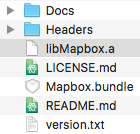mapbox-gl-native
Integrating the Mapbox iOS SDK into your application
This document explains how to build a development version of Mapbox iOS SDK for the purpose of incorporating it into your own Cocoa Touch application.
Requirements
The Mapbox iOS SDK and iosapp demo application build against the iOS 7.0 SDK. They are intended to run on iOS 7.0 and above on the following devices and their simulators:
- iPhone 4S and above (5, 5c, 5s, 6, 6 Plus)
- iPad 2 and above (3, 4, Mini, Air, Mini 2, Air 2)
- iPod touch 5th generation and above
Build
- Install core dependencies.
- For development on OS X, you can install pkg-config using
brew install pkg-config
- For development on OS X, you can install pkg-config using
-
Install jazzy for generating API documentation:
[sudo] gem install jazzy - From the path at the root of the project, e.g.
/path/to/mapbox-gl-native $, runmake ipackage # makes ./build/ios/pkg/static/The packaging script will produce the statically-linked
libMapbox.a,Mapbox.bundlefor resources, aHeadersfolder, and aDocsfolder with HTML API documentation.

- In addition to
make ipackage, other make commands includemake iproj # makes ./build/ios-all/gyp/ios.xcodeproj/After opening
ios.xcodeproj, you will see a couple of targets


Access Tokens
The demo applications use Mapbox vector tiles, which require a Mapbox account and API access token. Obtain an access token on the Mapbox account page.
Set up the access token by editing the scheme for the application target, then adding an environment variable with the name MAPBOX_ACCESS_TOKEN.


Test
In the context of your own app, you can now either:
CocoaPods
Currently, until #1437 is completed, to install a development version of Mapbox GL using CocoaPods you will need to build it from source manually per above.
-
Zip up the build product.
cd build/ios/pkg/static ZIP=mapbox-ios-sdk.zip rm -f ../${ZIP} zip -r ../${ZIP} * -
Modify a custom
Mapbox-iOS-SDK.podspecto download this zip file.{...} m.source = { :http => "http://{...}/mapbox-ios-sdk.zip", :flatten => true } {...} -
Update your app’s
Podfileto point to theMapbox-iOS-SDK.podspec.pod 'Mapbox-iOS-SDK', :podspec => 'http://{...}/Mapbox-iOS-SDK.podspec' -
Run
pod updateto grab the newly-built library.
Binary
-
Built from source manually per above.
-
Copy the contents of
build/ios/pkg/staticinto your project. It should happen automatically, but ensure that:Headersis in your Header Search Paths (HEADER_SEARCH_PATHS) build setting.Mapbox.bundleis in your target’s Copy Bundle Resources build phase.libMapbox.ais in your target’s Link Binary With Libraries build phase.
-
Add the following Cocoa framework dependencies to your target’s Link Binary With Libraries build phase:
GLKit.frameworkImageIO.frameworkMobileCoreServices.frameworkQuartzCore.frameworkSystemConfiguration.frameworklibc++.dyliblibsqlite3.dyliblibz.dylib
-
Add
-ObjCto your target’s “Other Linker Flags” build setting (OTHER_LDFLAGS).
Troubleshooting
On OS X, you can also try clearing the Xcode cache with make clear_xcode_cache.